Cell boosters for pandemic times, testing Shakespeare Stream & SureCall Fusion2Go
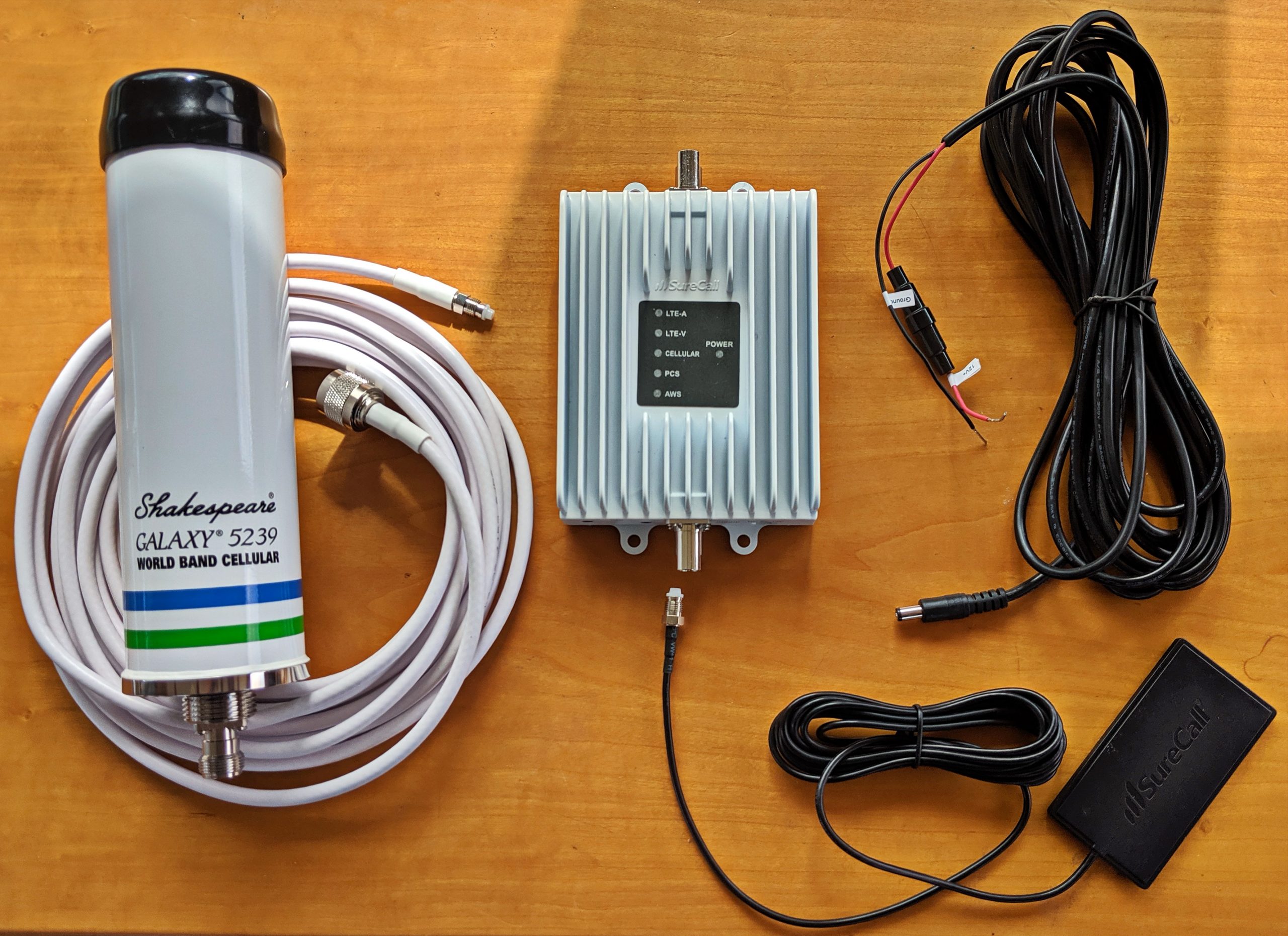
With COVID-19 stalking the planet, settling down in a remote Maine anchorage sounds even more attractive than usual. But I’ll also want a connection to family, news, etc. even more than usual, and reliable cell service remains a longterm issue in many of the sweetest spots along this coast (and elsewhere), despite what the service provider coverage maps show. So I’m pleased to report on two related cell boosters that have already worked pretty well for me.
Last summer I installed the Shakespeare Stream Wireless Internet Booster above and tested it in some of our favorite cell holes not far east of Camden. Yes, it seems like some of the best places to lay on a hook for several days are at the very fringe of cell service, and also lacking hotspots that might be tapped with a good WiFi booster. Then again, time spent quietly aboard with your favorite mate — going ashore mainly to hike lightly used and gorgeous island trails — might be social distancing at its best.
Actually I saw mixed results with the Shakespeare Stream, but mainly because my local Verizon service can sometimes be much worse than the signal strength indicates. While I’ll explain that lesson learned below, I remain confident that the Stream itself is good at boosting usable signal because Gizmo was equipped with a very similar system since early 2018, including a slow cruise from North Carolina to Maine.
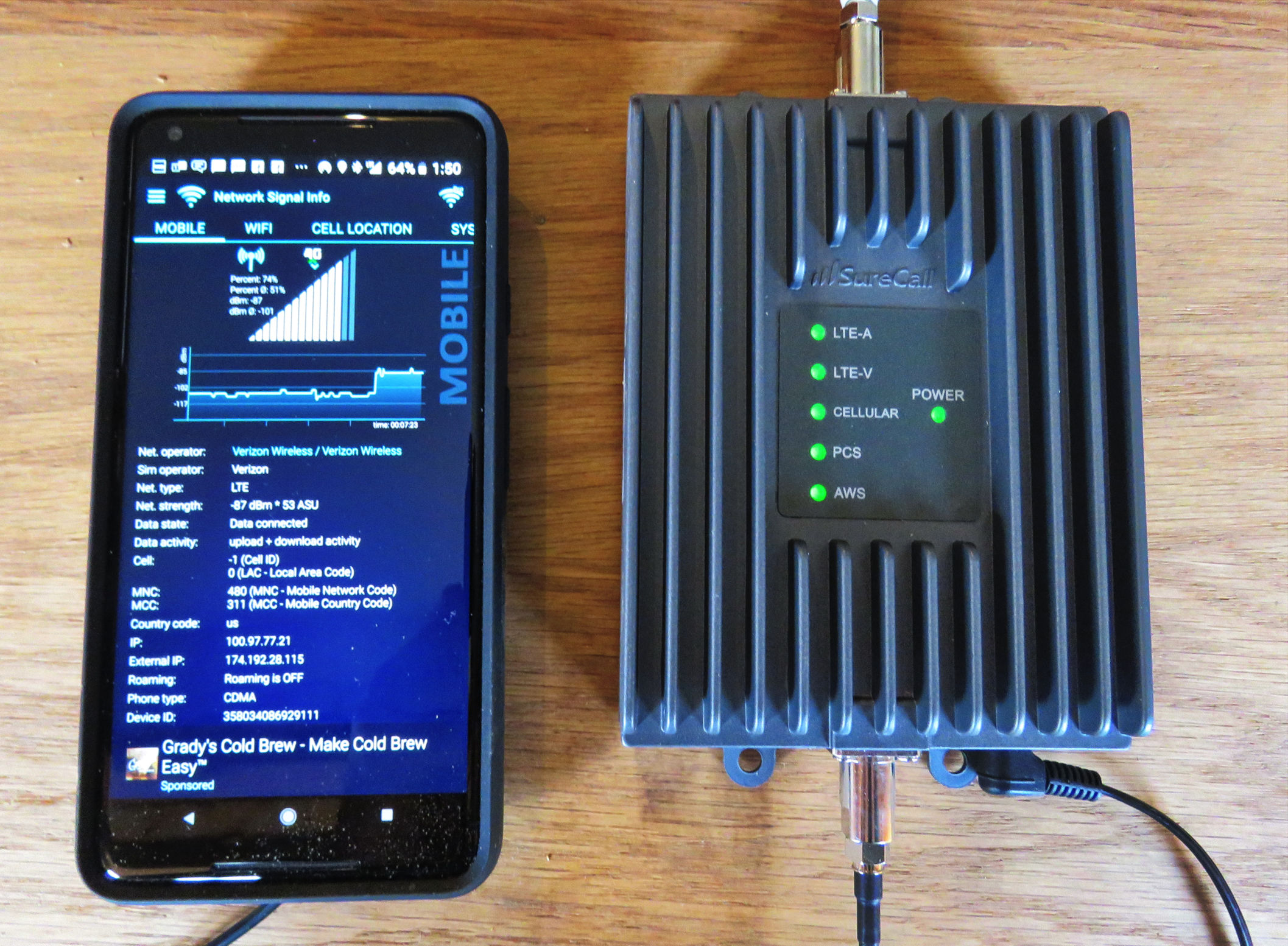
To be specific, the Shakespeare Stream marine booster kit uses the same basic SureCall Fusion2Go technology I first tested back then. And that’s not a bad thing. While SureCall custom manufactures the Stream with added protective internal coatings and the yacht white paint job, both operate in the same fully automatic and informative manner. In other words, when properly installed, the Stream also lights all those LEDs solid green to indicate that it’s ready to improve those various cellular signal types, and may already have boosted one significantly, as graphed on my phone by the Network Signal Pro app.
So the SureCall booster, white or gray, can be installed out of sight. But I advise mounting it somewhere where you can peek at the LED array if the boosting isn’t obvious on your phone shortly after poor service causes you to power up the system. Or if the boosting gets flaky. That’s because the LED for the service you’re using — LTE-V in my case — will blink green if the booster is automatically adjusting gain due to “oscillation or overpowering” and then red if it fails to resolve the issue.
That may never be a problem on boats with sufficient separation between the outside and inside antennas, but you won’t know for sure until the booster has automatically adjusted to its maximum 50dB gain in a very fringe area, and there may then be ways to improve the install on the fly (funky example further below).

It’s worth noting that the white Shakespeare Stream above is actually equivalent to the improved Fusion2GO 3.0 model that succeeded my test 2.0 device, and that all such currently available FCC approved designs are members of the post booster crackdown generation. The rumors of cell providers cutting off boaters because their cell boosters caused trouble for other customers — or of FCC agents coming to marinas to seize equipment — are thankfully in the past.
But along with the strict new technical requirements also came user rules. You “must register your booster with your wireless provider” and I (belatedly) found Verizon’s online registration site here. Also, only specific manufacturer-approved antennas and cables are allowed with specific boosters, because the total amplification is the sum of all parts. But I’m dubious that anyone much cares at this point because it seems like the automated “oscillation or overpowering” protections really work.
As for the final warning on the Fusion2Go 2.0 label — “This device may be operated ONLY in a fixed location for in-building use.” — I haven’t a clue. These SureCall devices are specifically titled Mobile Signal Boosters, and they meet mobile booster standards that are actually somewhat stricter than what’s allowed in fixed situations.
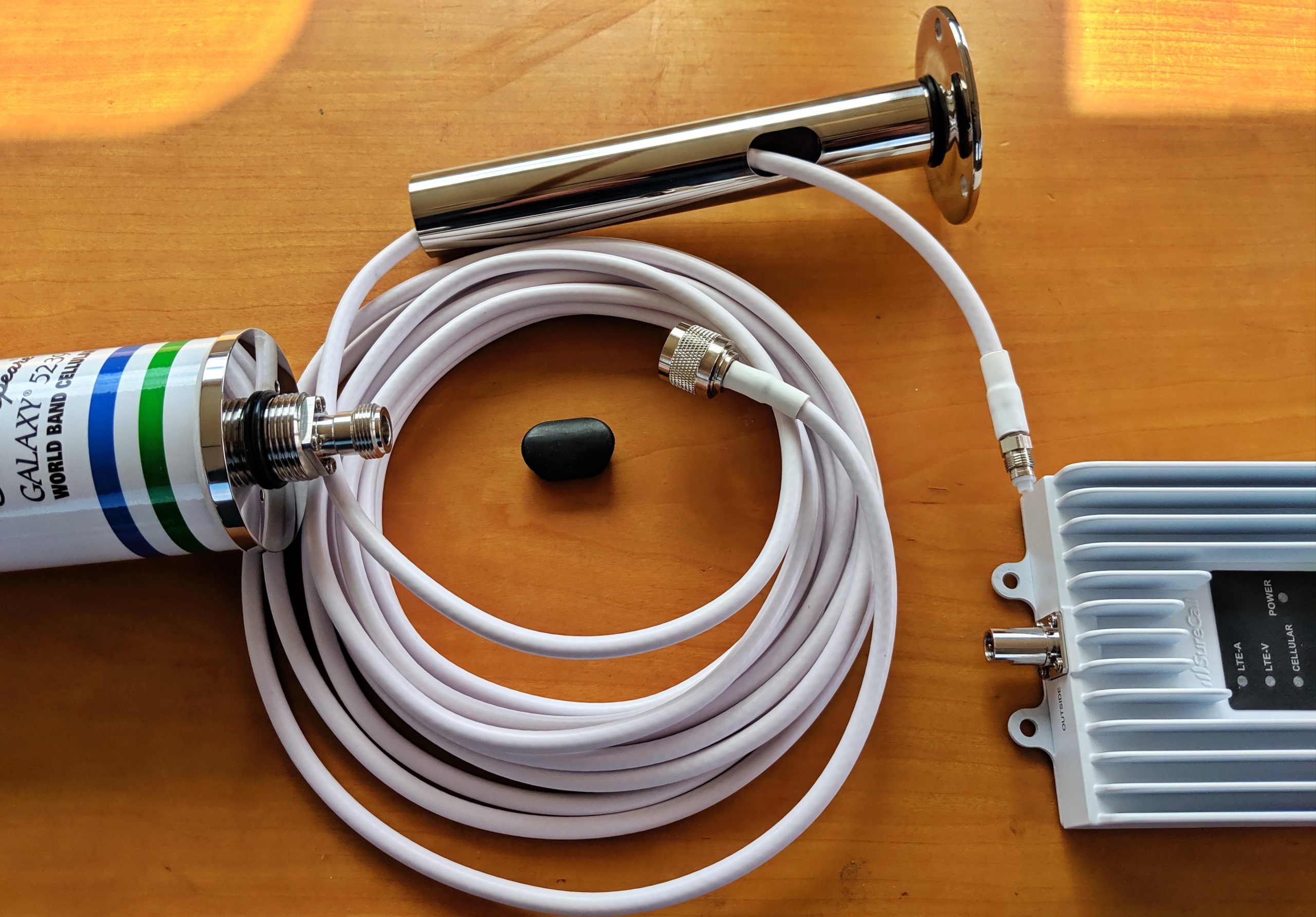
The Shakespeare Stream kit includes their Galaxy 5239 cell antenna along with the stainless sleeve and standard 1″-14 threaded marine base seen above. That makes for a neat and strong boat install, and you can even thread the small FME male connector through the mount’s bottom and a cabin top or masthead hole to hide the co-ax completely.
But note that the N-type female connector at the antenna end of the included 20-foot SC-240 cable won’t fit through any 1″ marine antenna mount I know of, and therefore must be screwed on before the sleeve and before running the cable anywhere it can’t be rotated easily. I keep hoping for a design that uses an unthreaded sleeve with set screws, but at least the antenna connector means that you can use a longer and perhaps lower loss coax cable if desired.
In fact, you can put together your own Fusion2Go 3.0 boat kit from a quality online source like Waveform, but it may not cost much less than an online Stream at $665, especially considering the added device waterproofing and Shakespeare’s marine-oriented tech support. And the Stream is also a booster that’s probably available through your boatyard or electronics installer.
I don’t wear a tinfoil hat, but sometimes Gizmo’s inside booster antenna and phone do! I vividly remember this spot as a lovely creek just off the ICW south of the Pamlico River that deserved some explore/hangout time if it hadn’t been for the snotty weather and very marginal cell connection. But when the hardworking Fusion2Go’s LTE-V light went solid red, the foil really did help to increase the effective distance between the little patch antenna fit into my phone mount and the big one up on the port spreader.

While antenna separation is an important consideration, Shakespeare’s illustration of a center console install is still reasonable because the two antennas are focused in parallel horizontal planes while the small separation is almost all vertical. Also note that the Stream kit is designed for the simple booster style I first wrote about in 2015 — phone in a fixed spot providing internet to other devices via WiFi and audio calls via Bluetooth headset (or a well-equipped geezer’s hearing aids). It can also work easily with a cellular hotspot device, and then all the phones on the boat can remain mobile.
But you may encounter places where a well-boosted 4G cell signal doesn’t mean a good internet connection. I captured this screen last summer while just across the Bay in peaceful Perry Creek and you can see by the graph that I struggled a bit with inside antenna placement as the Stream fought to boost the thin Verizon signal it could see from the mast spreader. And it sure looked like it succeeded in overcoming the Vinalhaven Land Trust Preserve topography that make the free moorings (set up by a generous cruiser) even more attractive.
But all those 4G bars didn’t mean much in terms of web browsing or even managing email, and I couldn’t understand why until I noticed the little “R” for roaming at the top of my phone screen and the “Extended Network” shown in the app — a surprise given my experience in these waters, and also given the Verizon coverage map.

Even if you drill into Verizon’s coverage map for better detail, you’d conclude that Extended (pink) 4G doesn’t start until you cruise past Schoodic. And shouldn’t it be about as capable as regular 4G anyway? I’m sorry to report that I later encountered nearly useless Extended Verizon in other cruising spots, and I already knew from lots of experience that while the (red) 4G shown on the western mainland above is for real, much of what’s splattered across that fantastic cruising area eastward is fantasy.
Last fall, I learned from T-Mobile testing that its rosy looking coverage map is even more flawed, and I don’t know of any cell service that covers Downeast coastal Maine well. But maybe we should think of it as a cruising and electronics challenge?

For this coming season, I’m moving Gizmo’s cell antenna to the masthead, and I also hope to test an unusually powerful booster that I plan to detail here soon. Getting a good connection to the boat in places like Perry Creek and McGlathery Island seems like a doable goal in this chaotic time. And, by the way, there’s plenty of cruising room up here. But who knows?
Right now I’m not even welcome to go ashore on North Haven and I completely understand why the little community quarantined itself. Meanwhile, my family and I are doing fine, so are the Steins living aboard in Fort Myers, and we plan to keep Panbo plugging along. And we certainly hope that readers everywhere are coping with the challenges, and that we’ll all be cruising on the backside of a well-flattened pandemic curve soon.


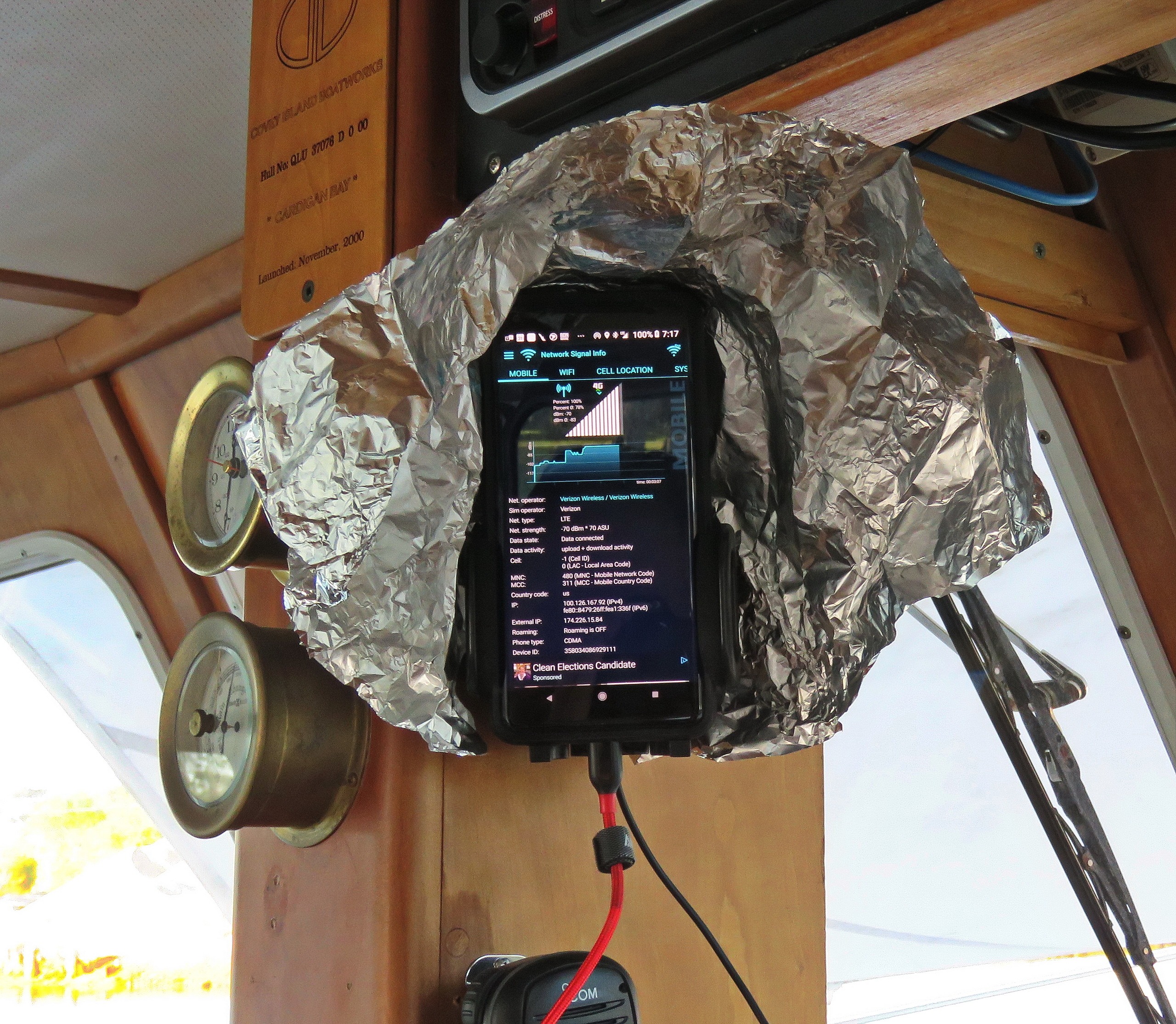

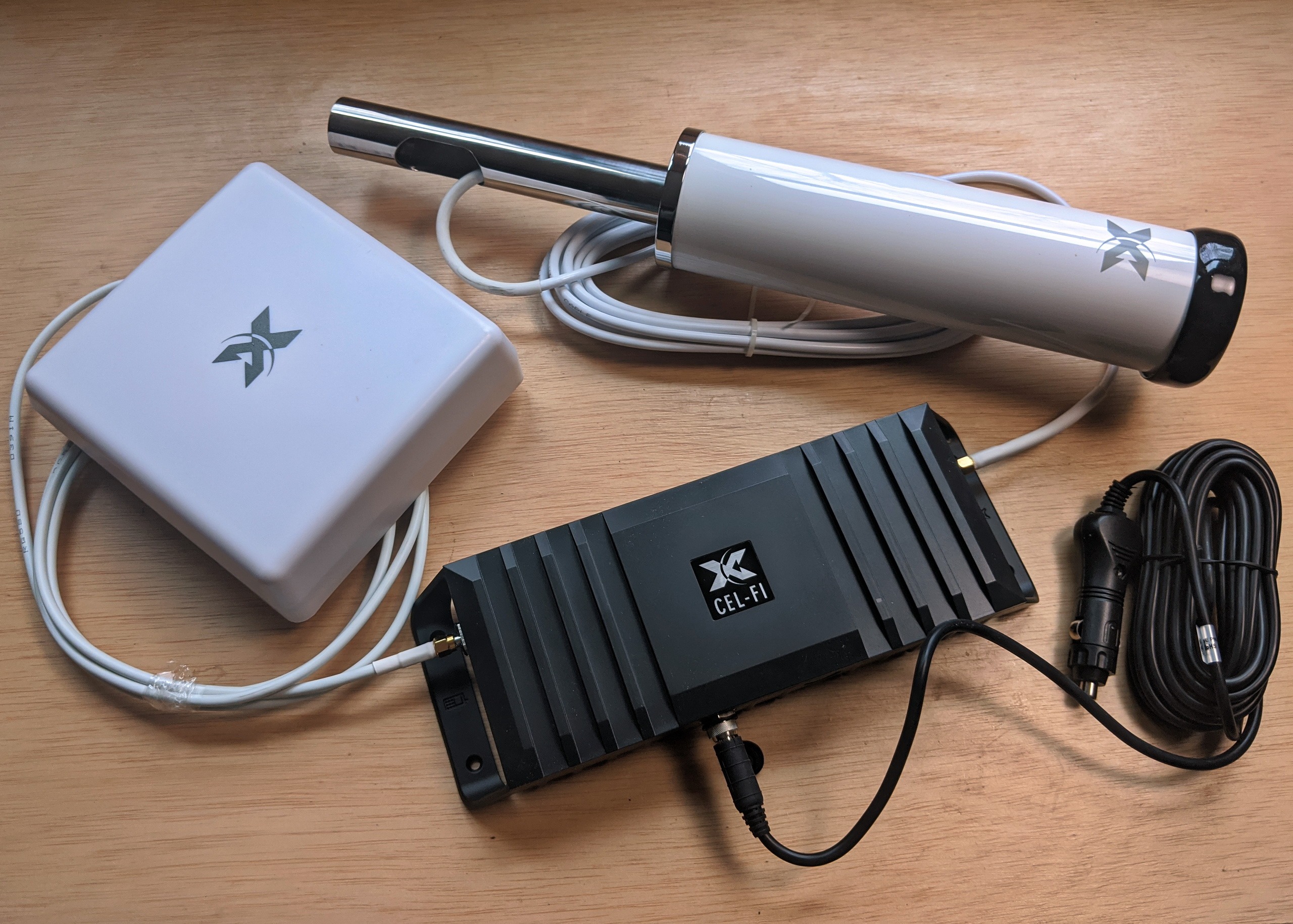
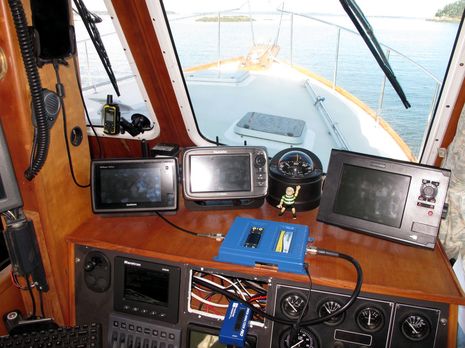

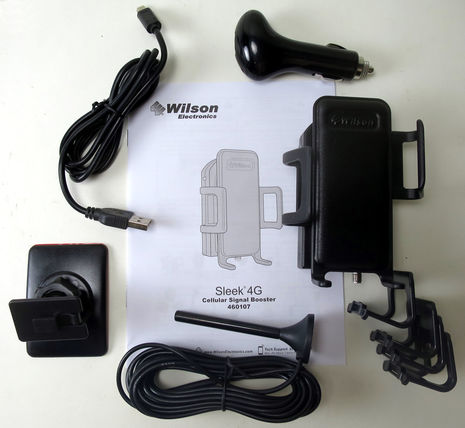








Hi Ben – any idea if either of these devices would connect to the TS-9 connectors on a NETGEAR LTE Modem LB2120? They both connect to their own onboard antenna, but I’d rather run everything through the LB2120 and have all devices utilize my onboard network (wired / WiFi).
Hmmm… connect the booster port meant to go to the inside antenna to the modem port meant for an optional external antenna? I doubt that will work, but don’t really know.
What should work is to simply put the modem or its antenna quite near the inside booster antenna, as suggested in the Shakespeare install excerpt above. That may also be a cleaner system when the booster is not needed, which may be a lot of the time depending on your location.
Also, I think that Waveform and Shakespeare both offer good tech support, at least in normal times.
Ben,
Did the Stream follow the WebWatch which seems to have disappeared. I have been looking at similar devices for a while, Webwatch, Glomex and the KVH Tracphone LTE-1. I need the device to be pretty simple.
Hi Will. The Stream is an addition to the recreational and commercial cell amps that Shakespeare Marine has long sold. And they show the WebWatch as still available, though I think that Ben Stein was hoping for some improvements before he reviewed it more thoroughly…
https://panbo.com/winegard-connect-marine-wifi-and-cell-internet-connection-simple-and-functional/
The story is similar for the KVH LTE-1 I’ve been long testing, at least here in Maine. It’s a powerful and super simple system that probably works great in many places but the two carriers they began with don’t even cover Camden Harbor reliably. KVH dealers in New England know that and the company has been hoping to offer a solution for some time…
The WebWatch is discontinued, due to poor performance. Units like the, Glomex Weboat or KVH LTE-1, the cellular signal is not boosted. The Stream or other Shakespeare cell boosters will extend your usable cell range.
Thanks for WebWatch update, Matt. But I’ve seen the KVH LTE-1 extend cell range very much like a booster and that didn’t seem surprising because inside the dome is a customized Pepwave Max 4G router running dual high Db antennas in diversity mode.
Hi Ben
Not sure if you allow image links, but I thought your readers might be interested to see the superyacht take on the KVH LTE-1. We’re putting the Celldome together at the moment amid coronavirus restrictions, it has 16 Promarine 5311 antennas on 2 groundplanes connected to a Peplink HD4MBX.
Thanks, Robert, very cool!
(FYI, an image link like you posted does let readers click to the photo, and it also makes it easy for us to put it on the Panbo server so it shows right up).
Also, readers curious about the celldome components can check Robert’s site: https://horizonme.eu/services/4g-5g-connectivity/
Maybe you could use the power of Panbo to get Verizon to add a couple of antennas. There is no reliable Verizon data service – even with a booster – on a line from North Haven to Southwest Harbor. Bizarrely, service is fine farther East even on most of Roque Island. Fortunately, AT&T still has an antenna on Swans Island that I use with a pay-as-you-go phone. For the last five years, I’ve called Verizon every September to complain. With little to show for it. I was told they were putting a short range antenna in SouthWest Harbor but don’t know if it happened.
Thanks, Carl. I doubt that Panbo has any sway at Verizon but I will write soon about an extra high power cell booster that might help it our area, and hopefully test it out there this season:
https://cel-fi.com/go-solutions/#GOMarine
Ben – interesting idea! Looking again, that Shakespeare guideline is “Place helm antenna within 1-2 inches of typical cellular device location” so I could make that work. But I hadn’t noticed “At least 8 inches (20cm) from any person” – that is pretty much going to dictate a Bluetooth connection to the phone – that’s three different wireless technologies strung together – and that sounds fiddly, especially for non-technical types.
I can’t argue with “sounds fiddly” and especially what I’ve been doing for many years when using cell data, which is to point Gizmo’s high-power WiFi system at the (sometimes boosted) phone in my pilothouse. It accomplishes your goal of having all onboard devices online via the same WiFi router, but the diagram (bottom of entry below) looks wireless crazy:
https://panbo.com/onboard-wifi-and-cell-booster-strategies-the-diagrams/
Actually I’ve found this multi-hop wireless to be reliable and easy to use once set up and understood. Then again, I’m sort of advantage in that impaired hearing means I’m quite used to having devices in my ears.
Ben – comparing these devices to what I have – a Wilson 301125 dual band (replaced by the 311125 tri band which it looks like I need now for the 700MHz) it looks like I have about 5db gain. Their 304420 is about the same and looks like the antennas in the packages you reviewed – it’s part of their marine kit https://www.wilsonamplifiers.com/weboost-drive-reach-marine-antenna-bundle-cell-phone-signal-booster-for-vehicles-470154-m/.
So this cellular antenna thing is 4 factors: a better antenna, in a better location (higher, less interference), plus “boost”, minus cable and transmission losses. For my (data) application I think I’m going to stick with a good passive antenna – I’m just losing the “boost”. And saving some money – the Wilson passive antennae are like $20.
Hi Keith, I can’t find a Wilson 311125 booster but if you have a tri band like this with manual gain controls …
https://www.wilsonamplifiers.com/tri-band-4g-v-amplifier-only-70db-verizon-wilson-805165/
… I think it’s from the middle generation where the boosters could detect “oscillation or overpowering” issues — even shut themselves down — but not automatically adjust for them. So that’s another factor in the equation. Apparently there are also numerous subtleties regarding how well a modern booster can squeeze real world performance within the modern booster standards. That’s why the Fusion2Go 3.0 is supposedly better than the 2.0. And why the WeBoost Drive Reach you linked to has earned some excellent reviews like:
https://seabits.com/weboost-drive-reach-cellular-amplifier-installation-and-testing/
https://www.rvmobileinternet.com/gear/weboost-reach/
Hi Ben – the 311125 is a passive antenna, no booster. Thank you for that SeaBits reference – that is exactly the architecture I’m using – with a different Wilson passive antenna and a different router (the LB2120 automatically fails over from WiFi to cellular). On the WiFi side I’ve been using a 2.4 Ubiquiti (had one on my previous boat for more than a decade – a bit gnarly to configure but I’m used to it) but I just received the Reach DB based on your recent review and will be replacing that soon.
Hi Ben,
I have had Fusion2Go booster on Bliss for many years and it has proven very useful in our travels up and down the east coast. I originally started with the Antenna you featured above but have tried several different ones with the system. My current favorite is from poyinting.. i have the OMNI-400 https://poynting.tech/product/omni-400/ which has much better gain and propagation pattern.
On biss the antenna is 18′ above the below deck antenna. On a recent crossing between SW Harbor, ME and Selborne NS, CA i was able to test and email 32 nautical miles off shore. That is a record for me. Interestingly but not surprising antenna hight makes a difference. Once the same passage a friend of mine using the same booster (with the Shakespeare antenna) was able to text me while 50nm offshore.
I also noticed what while in Canso NS his system was provided faster and better connectivity than mine. So… although antennas are important installation location is also very important.
Greater vertical distance allows the amplifier to amplify the signal more without creating a feed back loop between the antennas.
Anyway… Fusion2Go has worked amazingly well for me and others and is highly recommended.
–luis
BTW… my friend has a crealock 40 with the above deck antenna 65′ above the one below deck.
Good to hear from you, Luis, and thanks as always for sharing the performance/install details.
Steve Mitchell is also a fan of the Poynting Omni antenna…
https://seabits.com/poynting-omni-antenna-testing/
… and I’m newly enamored with a boosting beast known as the Cel-Fi GO+:
https://panbo.com/cel-fi-go-a-truly-different-and-promising-cell-booster/
Hi Ben,
Looking forward to your on-the-water experience with the Cel-FI GO+.
Take care…
–luis
Hi Ben,
Well, one of the designated projects this winter (while Atsa sleeps on the hard in MD) was to get ready to put in a cell booster in the spring. I scored the masthead antenna (same as the one you show here) and the 100′ of good cable to run up the mast (which I have to do anyway, since the RG-8 to the masthead VHF has water in it (grrr..) ). I’m about to pull the trigger on a Surecall fusion2go 3.0, but I thought I’d check back in and see if it’s still on the “recommended list” 🙂
Hartley, I still think that the Surecall/Shakespeare booster is a solid choice, but also that it and virtually all the other boosters are “old school” compared to the Cel-Fi GO+. I gave the latter quite a workout in various difficult to otherwise impossible Maine cell areas last summer and was quite impressed. Often it does a very good job completely automatically, but you can also see exactly what it’s doing and apply all sorts of tweaks that can be quite effective. It is expensive, it can only boost one service provider at a time, and it’s probably not appropriate for someone unwilling to learn the management tools that can improve performance even more, but at least you’re not the latter type.
https://panbo.com/cel-fi-go-a-truly-different-and-promising-cell-booster/
PS Yes, I got the Cel-Fi to conquer the Perry Creek cell hole, at the very same mooring where I emphatically learned that signal strength does not always equate to actual performance. Being able to choose which bands to use plus 100dB mode was the Cel-Fi advantage.
Hi Ben! Yes, I read your piece on the Cel-Fi, and I am more than a bit concerned about how it would perform in places like the Bahamas and Caribbean (assuming we get to go there again!) I also note that none of the Canadian carriers I’m familiar with show up in the list of compatible systems.
For domestic use, it looks like a solid choice, albeit a bit spendy! I do like the look of the management ability – I have a lifelong distrust of “automatic” tools of any sort 🙂
Thanks DE Hartley
p.s. Having straightened out the rat-nest behind my nav station, I may actually write up that bit about our antenna patch panel (and other lightning measures) aboard Atsa.
How does the Cel-Fi deal with “roaming”? We have Verizon, and we’ve been generally pleased, but I’ve noted that we are “roaming” in some places in the US.
OK, that was strange – the Panbo site re-arranged the paragraphs in my reply — the last paragraph should be the second one.
HJ
Yes, the Cel-Fi GO+ works with Verizon roaming, at least up here. In fact, that’s a problem it can solve, as at least up here the roaming “partner” does not seem to give Verizon customers decent data service. So with Cel-Fi you figure out what band is being used for roaming and turn it off hopeful that the Cel-Fi can then boost a weaker but much better performing Verizon signal. That’s what worked for me in Perry Creek and also over in the islands off Stonington.
It should be easier to find the list of carriers that Cel-Fi works with online, but here they are for U.S. and Canada as of a July 2019 press release:
Verizon, AT&T, T-Mobile, Sprint, U.S. Cellular, GCI Alaska, Rogers, TELUS, Bell Mobility, SaskTel, Freedom Mobile, Vidéotron, and Eastlink.
I’m going to ask about Bahamas and Caribbean coverage.
Here in Prince William Sound in Alaska, AT&T contracts with Cordova Telecom as they have the only 3 cell towers sited on islands in the sound. I’m currently trying to select a signal booster, and this is our primary cruising ground……should I be concerned that I don’t see Cordova Telecom on your list? Could you perhaps inquire about that one as well?